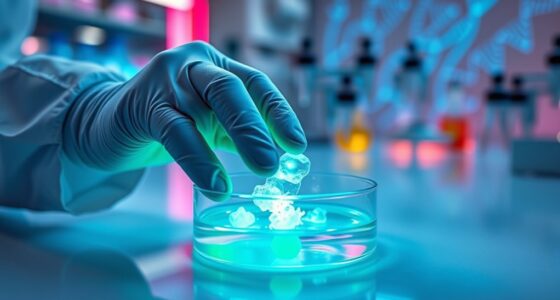Heather Dewey-Hagborg’s genetic art transforms DNA data into striking visual portraits, challenging ideas of identity and privacy. She extracts genetic markers from discarded samples to create realistic sculptures and images, raising questions about personal data and consent. Her work blends science and creativity, prompting discussions on ethics and technology. As you explore further, you’ll uncover how her projects inspire both awe and concern about the future of biometric art and individual privacy.
Key Takeaways
- Heather Dewey-Hagborg creates DNA portraits by transforming genetic data into visual art, exploring identity and privacy issues.
- Her projects, like Stranger Portrait Series, generate realistic images of individuals from DNA samples.
- Dewey-Hagborg’s work raises ethical questions about genetic privacy and consent in biometric art.
- Her installations visualize DNA as sculptures or projections, blending forensic science with artistic expression.
- The artist’s work challenges perceptions of personal identity and prompts societal debates on genetic data use.
The Origins of DNA Portraiture
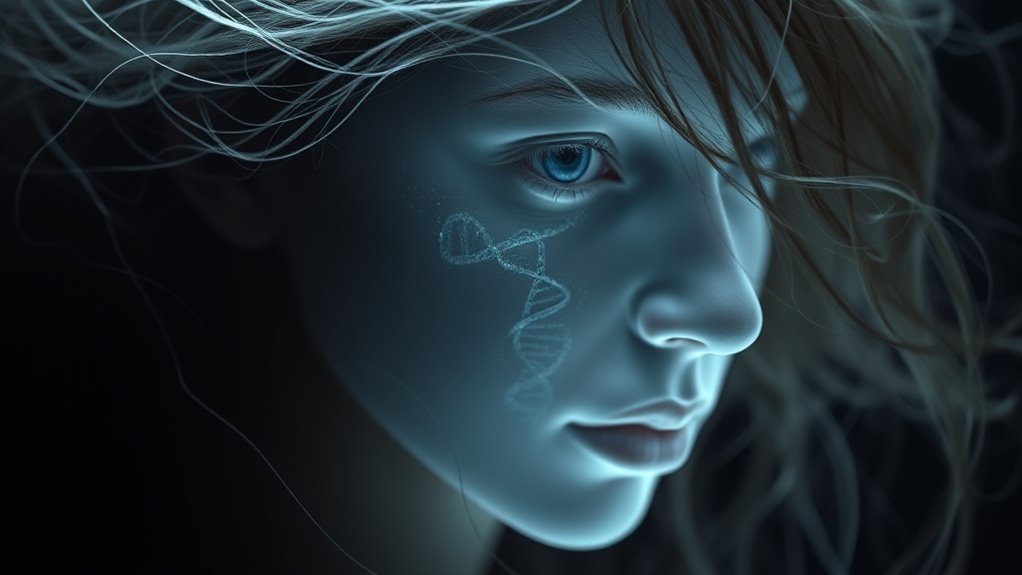
The origins of DNA portraiture trace back to the idea that your genetic material can reveal personal identity beyond traditional photographs. This concept merges biometric art with forensic aesthetics, transforming how we perceive individuality. Artists and scientists began exploring how DNA can serve as a visual signature, creating portraits from genetic data rather than paint or photography. These early experiments blurred the line between art and forensic science, emphasizing the unique and intrinsic qualities of your DNA. The approach challenged conventional notions of portraiture, suggesting that your genetic code itself could be a form of visual expression. This foundation set the stage for more sophisticated and provocative works, where the raw science of genetics becomes a tool for personal and artistic exploration. Additionally, advances in DNA analysis techniques have made it possible to generate more detailed and accurate representations, pushing the boundaries of what is possible in DNA-based imaging and artistic interpretation.
The Artistic Process Behind Genetic Representations

Creating genetic representations involves a meticulous process where science and art intersect. You start by analyzing DNA samples, extracting unique genetic markers that serve as biological symbolism for an individual. This data guides your aesthetic experimentation, transforming abstract genetic information into visual forms. You employ techniques like 3D modeling and sculpture to craft faces that reflect genetic traits, emphasizing physical features like jawlines or eye color. Every step balances scientific accuracy with artistic interpretation, aiming to evoke emotion or provoke thought. The process isn’t purely technical; it’s an exploration of identity through biological symbolism. Additionally, understanding the genetic markers used in DNA analysis helps inform the accuracy of the representations, ensuring they are rooted in scientific authenticity. Your goal is to create representations that are both scientifically grounded and artistically compelling, blurring the lines between biology and visual art in a transformative way.
Ethical Considerations and Privacy Concerns
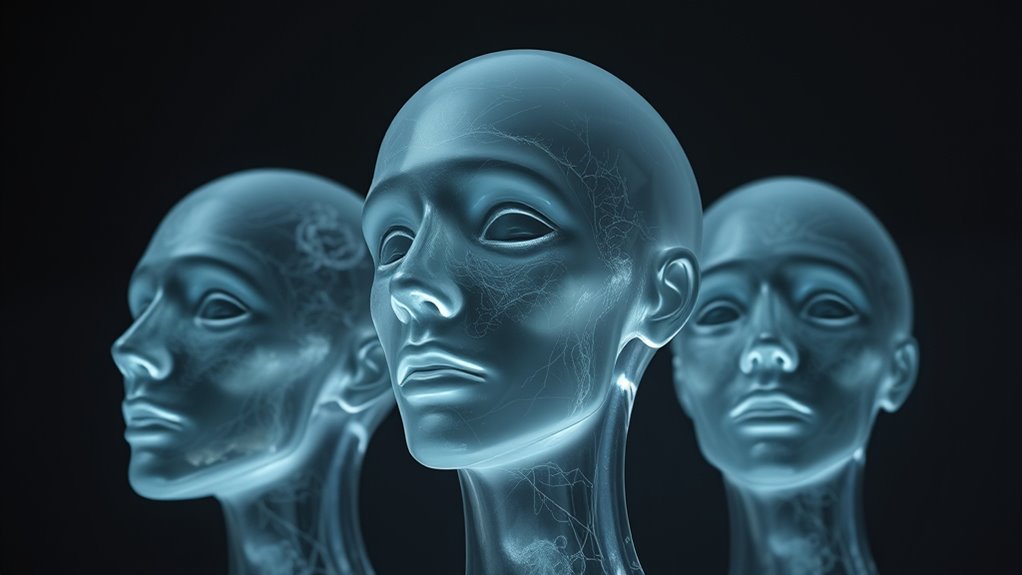
As genetic art becomes more prevalent, ethical considerations and privacy concerns inevitably come to the forefront. You might wonder how your genetic privacy is protected when artists or researchers access DNA samples without explicit consent. These consent dilemmas pose serious questions: do individuals have the right to control how their genetic information is used or displayed? When genetic portraits are created from discarded or anonymous DNA, it challenges notions of privacy and ownership. You need to consider whether such art respects personal boundaries or risks exposing sensitive information. Without proper safeguards, your genetic data could be misused or lead to unintended identification. Additionally, the use of Pimple Patch technology in skincare illustrates how targeted treatments can be applied ethically and effectively, emphasizing the importance of consent and proper use. Addressing these ethical issues is vital to guarantee that genetic art advances responsibly without compromising individual rights.
Technological Innovations in Genetic Art

Advancements in technology have revolutionized genetic art, enabling artists and scientists to produce highly detailed and personalized works. Biological artistry now leverages cutting-edge tools like CRISPR, DNA sequencing, and synthesis to transform genetic material into visual representations. Genetic visualization techniques allow for the detailed mapping of DNA to generate realistic images or sculptures, making hidden genetic information tangible. These innovations make it possible to create portraits or abstract art rooted in individual genetic data, pushing the boundaries of traditional art forms. As technology improves, the resolution of genetic images continues to enhance, allowing for even more precise and accurate artistic representations. Such technological progress fosters new ways to explore identity, genetics, and human variation. As a result, genetic art becomes a dynamic intersection of science and creativity, offering novel perspectives on biological individuality while expanding artistic expression through precise, innovative methods.
Notable Projects and Exhibitions
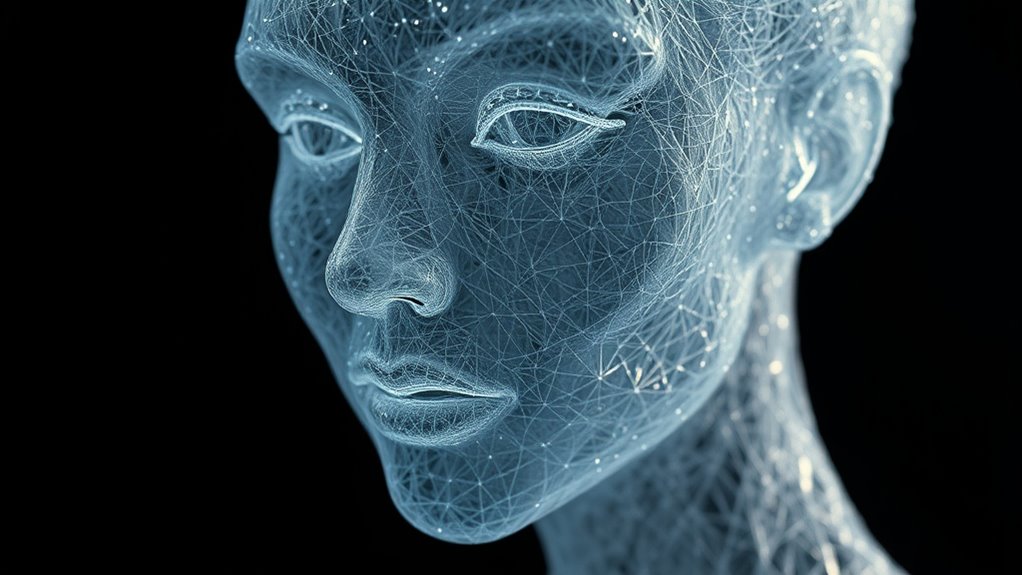
Heather Dewey-Hagborg’s notable projects, like the Stranger Portrait Series and Ghost Genome installations, have attracted widespread attention. These works challenge viewers to contemplate identity and privacy in the age of genetic technology. Her exhibitions and recognition highlight her influence in expanding the boundaries of artistic expression through genetics. As AI advances, artists like Dewey-Hagborg utilize genetic data to explore new dimensions of creativity and ethical considerations.
Stranger Portrait Series
The Stranger Portrait Series by Heather Dewey-Hagborg captures the imagination by transforming genetic data into hauntingly realistic portraits of unknown individuals. This project challenges notions of genetic privacy, revealing how hidden DNA can be turned into biomolecular aesthetics that evoke both curiosity and ethical questions. Her work prompts you to contemplate the power and vulnerability of genetic information in public spaces. By reconstructing faces from discarded objects like hair and gum, Dewey-Hagborg pushes the boundaries of art and science. The series underscores how our genetic footprint can be used creatively, yet raises concerns about privacy and consent. It’s a provocative exploration of identity, revealing the potential—and perils—of biomolecular aesthetics in a world increasingly driven by genetic data. The project also draws inspiration from dog names, demonstrating how naming conventions can reflect cultural and personal identities.
Ghost Genome Installations
Building on the provocative ideas of transforming genetic data into visual art, Ghost Genome installations take this concept into immersive, large-scale exhibitions that explore the unseen layers of our biological identities. You’re immersed in biotech aesthetics that challenge traditional notions of portraiture, revealing the complex intersection of genetics and personal history. These installations utilize genetic storytelling to visualize DNA sequences as vibrant, dynamic sculptures or projections, making invisible information tangible. Notable projects often feature interactive components, allowing viewers to engage with the data and question notions of identity, privacy, and biological determinism. Through these large-scale displays, Dewey-Hagborg’s work prompts reflection on how genetic material shapes our understanding of ourselves, blurring the line between science, art, and personal narrative.
Exhibitions and Recognition
Have Dewey-Hagborg’s innovative genetic artworks gained widespread recognition? Absolutely. Her work has been featured in prominent museums and galleries worldwide, sparking conversations on ethics and identity. Curators appreciate how her pieces challenge traditional notions of portraiture, prompting meaningful dialogue in museum curation. Her exhibitions often draw large gallery receptions, where audiences engage directly with her thought-provoking pieces. Dewey-Hagborg’s projects, like “Stranger Visions,” have traveled internationally, cementing her reputation as a pioneer in genetic art. Critics and viewers alike praise her ability to blend science, art, and social commentary seamlessly. Her recognition continues to grow, inspiring new collaborations and elevating the dialogue around genetic privacy and artistic expression.
The Intersection of Science and Creativity

You can see how art from DNA blurs the line between science and creativity, turning genetic data into striking visuals. Science fuels new ideas and techniques, inspiring artists to explore uncharted territories. Yet, as you explore these innovations, you also need to contemplate the ethical questions they raise. Embracing failure in creativity as part of the process can lead to unexpected breakthroughs and innovative approaches in this emerging art form.
Art From DNA
Art from DNA merges scientific techniques with creative expression, transforming genetic material into compelling visual interpretations. By analyzing DNA samples, artists like Dewey-Hagborg explore biomolecular identity, revealing personal traits and stories. This process raises questions about genetic privacy, as genetic information becomes a form of artistic material, blurring boundaries between personal data and art. Using technologies such as DNA sequencing and forensic analysis, artists can create portraits or sculptures that reflect an individual’s genetic makeup. These works challenge viewers to contemplate how genetic information can be visualized and interpreted beyond scientific contexts. Ultimately, art from DNA turns complex biological data into powerful, thought-provoking visuals, illustrating the profound connection between our genetic blueprint and self-identity.
Science Inspires Creativity
Science fuels creativity by providing new tools, concepts, and perspectives that inspire innovative artistic expression. Through genetic storytelling, you can transform DNA data into compelling narratives that reveal personal histories and identities. Heather Dewey-Hagborg’s work exemplifies this, blending science with art to explore biomolecular aesthetics—visual forms inspired by molecular structures. These approaches challenge traditional notions of portraiture, turning genetic information into visual art that prompts reflection on identity and privacy. As you engage with this intersection, you recognize how scientific advancements open new avenues for artistic exploration. This fusion encourages you to see DNA not just as biological material but as a medium capable of conveying stories and aesthetic beauty, pushing the boundaries of both science and art into a unified, creative sphere. Hydrogen fuel cells offer a compelling example of how scientific innovations can inspire new artistic and conceptual explorations.
Ethical Considerations
As genetic art pushes the boundaries of creativity, it also raises significant ethical questions about privacy, consent, and the potential misuse of personal genetic information. Privacy risks are at the forefront, as collecting and analyzing DNA can reveal sensitive details about individuals without their knowledge. You might wonder who has access to this data and how it could be exploited. Consent challenges also arise because obtaining explicit permission from individuals before using their genetic material isn’t always feasible, especially when samples are collected from public spaces or discarded items. These ethical concerns highlight the need for strict guidelines and transparency in genetic art projects. Balancing innovation with respect for personal rights ensures that artistic expression doesn’t compromise individual privacy or autonomy. Additionally, the integration of natural materials and vintage decor in related design fields underscores the importance of respecting individual and cultural identities in creative endeavors.
Public Reactions and Societal Impact
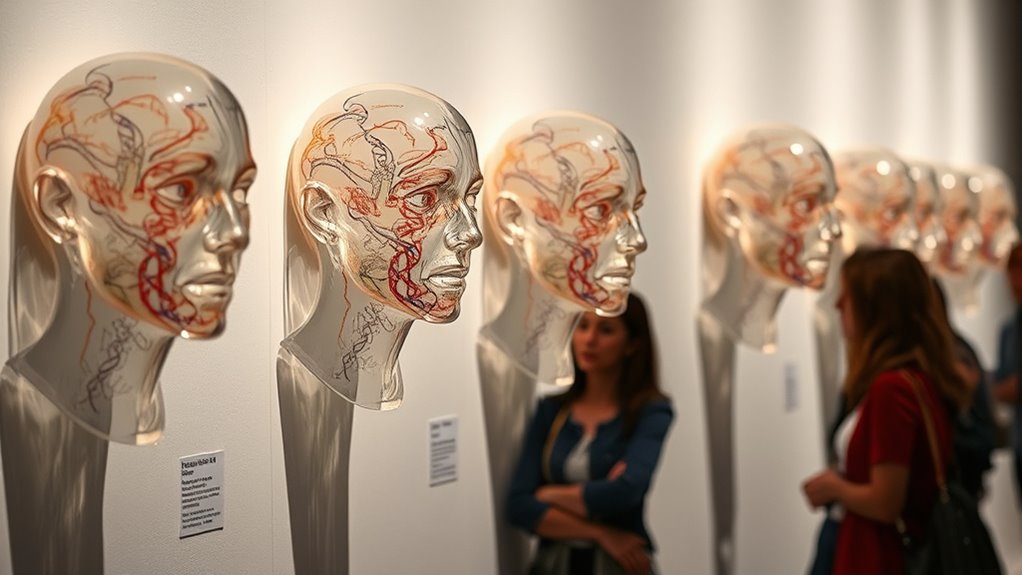
Public reactions to Heather Dewey-Hagborg’s genetic art have been mixed, sparking both fascination and concern. Many find it intriguing how her work challenges traditional notions of privacy and identity, prompting debates about personal data and surveillance. Public opinion varies: some see her art as a powerful commentary on genetic information’s potential, while others worry about misuse or societal implications. Cultural acceptance of this form of art remains uneven; it’s praised in progressive circles but met with skepticism elsewhere. Her work forces you to contemplate how society perceives genetic data, raising questions about transparency, consent, and control. Additionally, concerns about digital literacy influence how the public interprets and reacts to her art. Ultimately, her art influences societal conversations about ethics, technology, and the boundaries of personal privacy in the digital age.
Future Possibilities in Genetic Portraiture
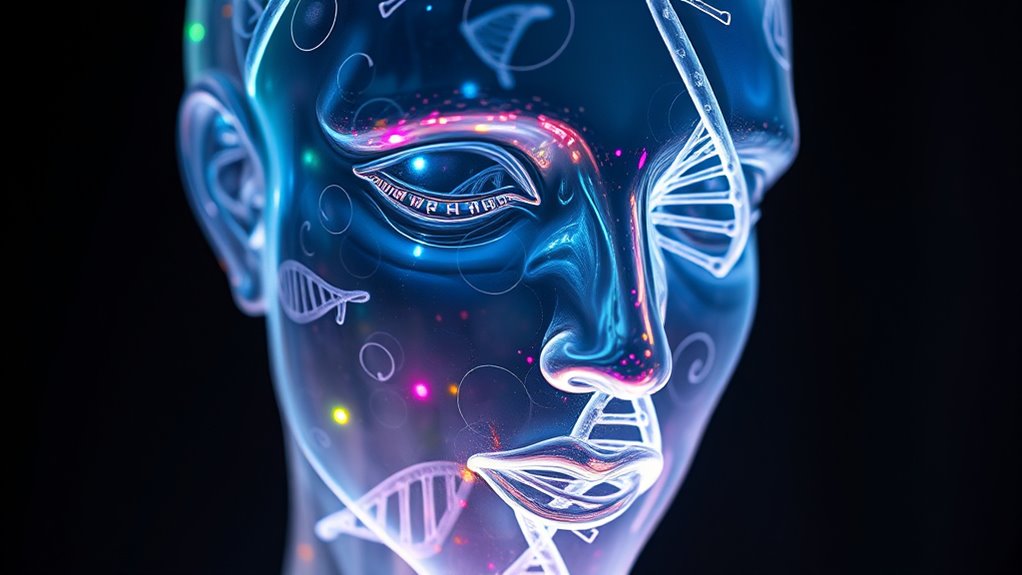
The future of genetic portraiture holds exciting possibilities that could redefine how you understand identity and self-expression. As technology advances, artists and scientists may develop more precise methods to reconstruct faces from genetic material. However, these innovations raise crucial biotech ethics questions about consent and privacy. You’ll need to consider who controls genetic data and how it’s used, especially as data security becomes more vital with increasing digital storage of sensitive information. Future tools might allow for real-time, personalized portraits based on genetic analysis, but safeguarding personal data will be essential to prevent misuse or unauthorized access. Additionally, privacy concerns will become increasingly prominent as these technologies evolve, necessitating robust regulations. While these developments open new creative frontiers, they also demand careful regulation to balance innovation with respect for individual rights and privacy concerns.
Reflections on Identity and Personal Data
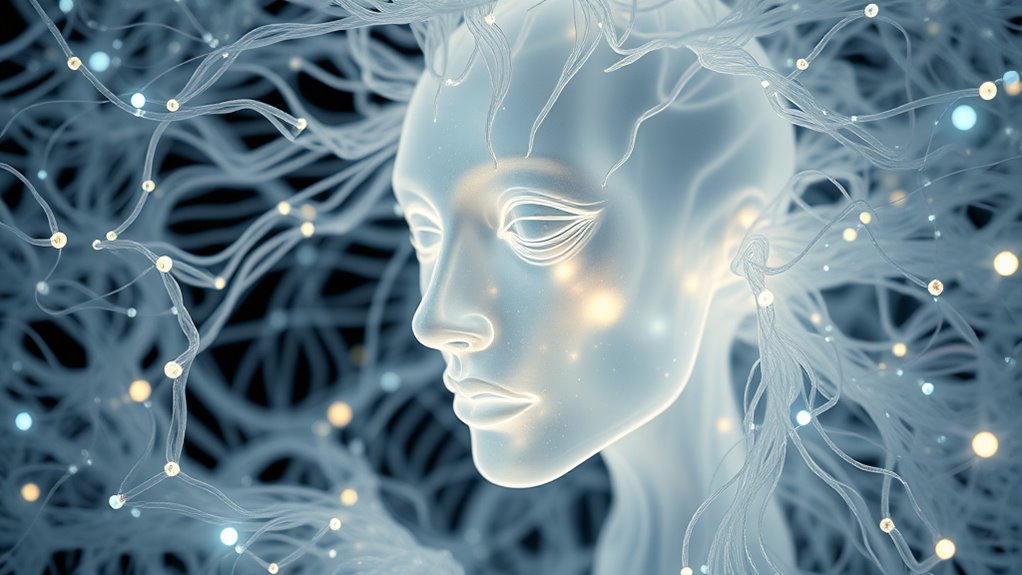
Advancements in genetic portraiture challenge how you perceive personal identity, prompting questions about what actually makes someone truly themselves. When your DNA can be used to recreate your image, it raises concerns about data privacy and who controls your genetic information. You might feel exposed or vulnerable, knowing that personal data can reveal more than just physical traits—it can hint at health, ancestry, or other sensitive details. This technology forces you to reevaluate how personal identity is protected in a digital age. As genetic art becomes more accessible, you need to consider how your data is stored, shared, or misused. Proper refrigerant management and secure data handling are essential to prevent environmental and personal risks. Ultimately, these developments urge you to reflect on the balance between scientific progress and safeguarding your personal data privacy.
Frequently Asked Questions
How Does DNA Portraiture Influence Our Perception of Identity?
DNA portraiture influences your perception of identity by revealing the complex connection between genetic identity and personal appearance. It challenges you to contemplate how much of who you are is shaped by your genes versus your environment. This art form questions the authenticity of visual identity, prompting you to think about the boundaries of artistic expression and the true essence of individual uniqueness. It blurs the lines between science and art, making you rethink identity itself.
What Legal Regulations Govern the Use of Genetic Information in Art?
You should know that legal regulations around genetic information in art focus on privacy concerns and intellectual property. Laws like the Genetic Information Nondiscrimination Act (GINA) protect your genetic data from misuse, while copyright laws address artists’ rights. However, regulations vary by country, and ethical debates persist about consent and ownership. Always stay informed about local laws to guarantee your use of genetic data in art respects privacy and intellectual property rights.
Can DNA Portraits Reveal Information Beyond Physical Appearance?
Yes, DNA portraits can reveal more than physical appearance, like genetic predispositions and health risks. You should consider genetic privacy concerns and artistic ethics, as sharing or analyzing such data might infringe on individual rights. When creating or viewing these portraits, be mindful of the sensitive information involved, ensuring ethical boundaries are respected. This awareness helps balance artistic expression with respect for personal genetic information.
How Accessible Is Creating a Dna-Based Artwork for the General Public?
Creating a DNA-based artwork isn’t very accessible for most people due to complex genetic privacy and ethical considerations. You’d need specialized equipment, knowledge, and legal permission, which can be costly and difficult to obtain. Ethical concerns about privacy and consent often restrict public use. So, while the idea is fascinating, it remains mostly in the domain of professional artists and researchers who navigate these sensitive issues carefully.
What Are the Potential Risks of Misusing Genetic Art Technologies?
You could unintentionally open Pandora’s box with genetic art, risking serious ethical concerns and threats to genetic privacy. Misusing these technologies might allow for identity theft, unauthorized surveillance, or discrimination based on genetic traits. As you explore this art form, be aware that careless handling or malicious intent can lead to profound privacy breaches, making it vital to establish strict ethical guidelines to prevent harm and protect individual rights.
Conclusion
As you explore Heather Dewey-Hagborg’s genetic art, you realize it’s more than just a portrait—it’s a breathtaking fusion of science and creativity that challenges your perceptions of identity. This groundbreaking work transforms your DNA into a mirror reflecting who you truly are, making it feel like your personal data has become a mesmerizing, living masterpiece. In this artistic revolution, your very essence becomes an awe-inspiring demonstration to the incredible power of technology and imagination.



